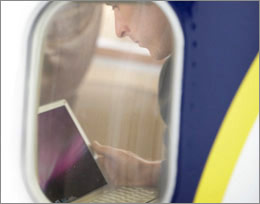In-Flight Wi-Fi FAQ
Web surfing, streaming video, and checking e-mail; in-flight Wi-Fi offers these features and more. Today’s services allow you to wirelessly connect your laptop, smart phone, or portable media player to the cloud as soon as you reach 10,000 feet and can turn on your electronics.
However, broadband is far from ubiquitous for today’s frequent flyer. Plus, the cost of the service will vary based on the duration of your trip and the device you’re using. We’ve assembled the need-to-know details to help you when booking your next trip.
How do in-flight Wi-Fi services differ?
Aircell’s Gogo service is the most popular. It uses the 3-MHz spectrum for air-to-ground connections, which means 3G antennas connect to the plane’s router, which your devices can then connect to. This service won’t work for international travel over oceans, and the connection can become congested and sluggish as more people use the same network.
LiveTV offers in-flight cable, XM radio, and movie services to AirTran, Frontier, and other airlines, but as of press time it only offered Wi-Fi on one plane in the JetBlue fleet. It uses air-to-ground connections on the 1-MHz spectrum, and it’s free, assuming you’re lucky enough to book a flight on BetaBlue, as the plane is called.
Used by Alaska Airlines and Southwest Airlines, Row 44 employs satellites to project broadband connections to planes. While this technology is more expensive for airlines to implement on their aircraft, it allows for better international coverage. Also, Row 44 claims that its service doesn’t suffer from congestion problems as more people log on from one plane.
How much does in-flight Wi-Fi cost?
Prices vary from one airline to another. Row 44 leaves pricing models completely up to the individual airlines; Alaska Airlines charges $7 per flight, while Southwest Airlines has not finalized pricing. If your service stops working during the flight, Alaska Airlines will offer a partial or full refund. Gogo can cost from $4.95 per flight to $49.95 for a 30-day pass. In addition to the initial fees, Gogo applies state taxes based on where a flight originated. New Hampshire, New Mexico, North Dakota, Ohio, South Dakota, Texas, Washington, and Wisconsin tax Internet services. As mentioned above, JetBlue’s LiveTV service is currently free.
How fast are these services?
Using Speedtest.net on a Gogo flight from San Francisco International Airport to New York’s John F. Kennedy International Airport on American Airlines, we saw download speeds of 1.6 Mbps, and 0.3 Mbps on the upload. Generally speaking, this is similar to what you’d experience from 3G coverage on the ground, depending on how many people are logged on simultaneously. Gogo admits that speeds may vary due to your device, atmospheric conditions, terrain, network capacity, and aircraft location; Aircell prioritizes different types of usage. Applications that use high bandwidth, such as file sharing, multiplayer gaming, streaming audio/video, and VoIP are given a lower priority, and may not work consistently or at all. Gogo plans to migrate to faster LTE 4G technology as the backbone for its service within the next three years.
Row 44 guarantees upload and download speeds of at least 100 Kbps per seat, but the company says your connection will be faster than that. Alaska Airlines claims peak speeds of 35 Mbps. LiveTV doesn’t specify speeds.
Sign up to receive The Snapshot, a free special dispatch from Laptop Mag, in your inbox.
Can you make VoIP calls from a plane?
There’s currently no FCC ban on this type of technology, but it’s against the law to place voice calls on standard wireless lines while flying. Gogo’s policy prohibits VoIP calls, and such sites as Skype are blocked by most of the airlines. LiveTV only allows messaging and e-mail, so VoIP sites are not accessible.
Will people be surfing for adult content?
The airlines do not have a unified position on adult content. For example, American Airlines, Delta Air Lines, and AirTran filter content, but Virgin America does not. In some cases, flight attendants will ask passengers to refrain from viewing adult content, as they would do with an adult DVD or magazine.


